Chapter 3
Building Brand ‘You’
“This above all; to thine ownself be true.”
Hamlet
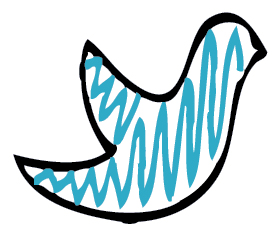
For those of you doubting the existence of the personal brand or asking yourself, “Why should I care about this branding stuff? It doesn’t apply to me or what I do?” let me provide you with a stark reality check.
We live in an age where a potential employer will Google you before even inviting you to an interview where, in all your interactions, both offline and on, your virtual reputation precedes your physical one 99 percent of the time.
Whether you’re still a student, looking for work, an entrepreneur, or an employee in a global corporation, you need to start thinking, acting, and planning like a leader and take control of brand “you.”
In the ever-evolving spectrum of social media, you have to learn how to master the ability to manage your online reputation. You need to be in control of all those impressions of you and to build on them in a way that will ensure your future success.
Your personal brand is all about who you are and what you want to be known for on an emotional, introspective level. You need to begin your journey with your eyes wide open and with a clear vision of your unique and very personal promise of value.
Your Personal Brand Statement
This is an exercise I like to do with every client I work with and I’m going to share it with you now: Write your personal brand statement in 140 characters or less!
It’s more difficult than it looks and will be distinctive to you and you alone. But what exactly is a personal brand statement?
The answer is that it is a statement that succinctly communications what you’re best at (your brand value), who you provide it to (your brand audience), and how you provide it (your delivery method).
After all, your personal brand statement is far more than a label, a job title, or a mission statement. And it’s not a bottom-line prophecy about your long-term career and life objectives. Don’t think of it in corporate terms but instead approach it from the inside out, because before you can start promoting brand “you,” you need to fine-tune your own understanding of exactly who brand “you” is.
When putting together your personal brand statement, remember to be absolutely clear on the value you provide to others and don’t confuse them by using woolly terms that really don’t mean anything. Stay focused on your area of expertise and remember that nobody wants to invest in a jack of trades, master of none.
Stay authentic, but don’t be afraid to dream a little. By this I mean that you shouldn’t be afraid to express your inner strengths in the statement, even if you have not yet flexed their virtual muscle, provided you know that they are genuine.
That old Einstein saying has never been truer than in the personal branding arena: “You do not really understand something unless you can explain it to your grandmother.” So, when constructing your personal brand statement, avoid using technical words or industry jargon that could alienate your audience. If your grandmother can understand it then so will your followers.
Understanding Your Emotional Value Keys
Step outside yourself for a moment and think about how your personality affects the experience someone will have with you from his or her perspective. For example, are you amazingly organized? Do people love working with you for your ability to empathize with others, or for your wonderful sense of humor? Now write down those words that best describe these assets of your personality. These are your emotional value keys.
Here are the key questions to ask yourself:
- How am I described by others?
- How would I like others to describe me?
- What benefit do I give to others?
- How do I provide these benefits?
- What benefits would I like to provide?
- What do I have that makes me stand out from everyone else?
Now pick five key words from your list, those that most clearly communicate who you are. The result should read like an inspiring mantra — either a being one, as in a “dependable, creative professional connector” or a doing one, such as “always motivating others to do their best.”
Now you have the five emotional value keys necessary to construct your personal brand statement in 140 characters or less. When it’s set down and embraced, not only will you start to see your personal brand in a whole new (and very personal) light, but so will your current and future followers.
My personal brand statement (see Figure 3-1) is a doing one, full of ambient social warmth that, over time, others have come to echo as my brand ambassadors.
Figure 3-1
@grattongirl’s personal brand statement

Let’s break my statement down to see the bare-bones of its construction: First, there is the word “delight,” an emotional word that describes how feelings of satisfaction, warmth, and accomplishment motivate me to work on behalf of others. Second, the word “helping” is an important and powerful word that conjures up subconscious feelings of needs being fulfilled and support being given. Next, I talk about the creation and unleashing of personal brand identity, letting my target audience know exactly what I can offer and whetting their appetite for more information. Finally, I provide another audience indicator and a method of delivery, which is “on Twitter.”
Your personal brand statement is the starting point from which your brand will be developed on Twitter. It must resonate warmth and convey to your audience the essence of who and what you are.
Your Brand Chemistry: The Vision, Value, Passion Connection
Another gift of the personal brand is the way it allows your potential clients, employers, and associates to look at your brand’s “chemistry” to assess whether it’s the right fit for their needs. Personal branding helps generate this chemistry for you by spotlighting your social warmth alongside your knowledge base and experience. People hire and work with people they like. They want people who will fit their corporate culture, so they want to know what kind of person you are. Your target audience expects nothing less than the whole package, and personal branding lets them see it more clearly.
So let’s do more homework and undertake an exercise I like to call the Vision, Value, Passion (VVP) Connection (see Figure 3-2). Set aside at least an hour for the exercise as it needs your absolute focus and attention to provide maximum benefits in building your brand.
Figure 3-2
The Vision, Value, Passion (VVP) Connection
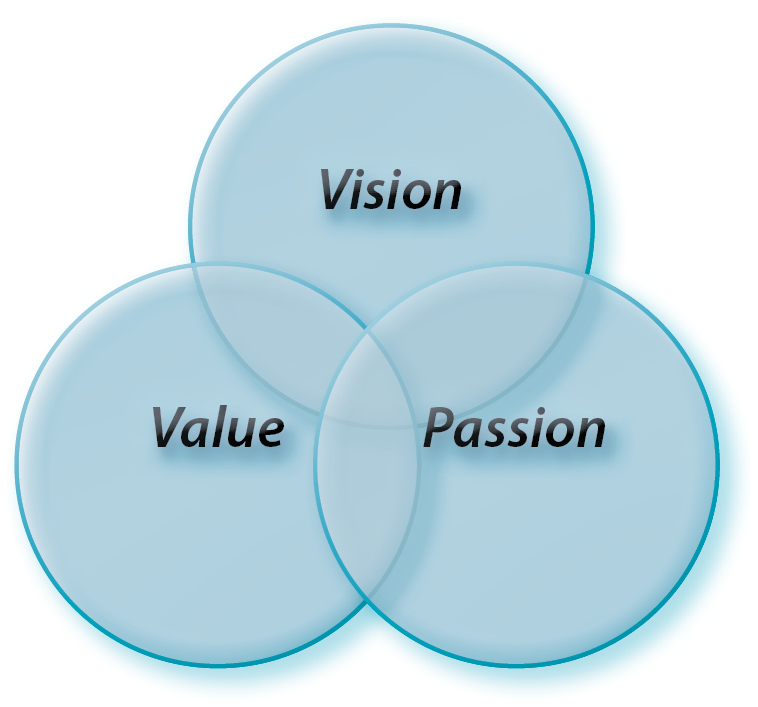
Vision
What is your vision and your purpose in life? I want you to look at this question from both an external perspective (the bigger picture) and an internal perspective (how you are emotionally driven to it) to clarify exactly what is it and how you feel you might best realize it.
Now, think about one problem that you want to see transformed and improved in your life. What role might your vision play in solving this? On many occasions, the problem’s solution often turns out to be the vision itself. Your role in making it happen is your purpose.
Value
What are your personal values, your moral boundaries, and your guiding principles? For example, honesty, integrity, sensitivity, enthusiasm, inner strength, and pride are all examples of the values we hold, both for ourselves and for others. Take time to write down your values.
Now, take time in defining where you feel your value system came from. One of the best methods of achieving this is through simple word association. It can take practice but word association can be a great tool in uncovering your inner belief system. Say each of your personal values aloud and write down the first word that comes into your head when you hear it, followed by the second, and then the third. Repeat this process for each of your values, and the results will surprise you.
The unconscious mind holds on to those core beliefs that drive our values every day, the ones that our conscious mind has filed away. This exercise helps you to unlock your values and is incredibly powerful and cathartic.
Passion
What fascinates you most? What activities, interests, and topics put a spring in your step and have you leaping out of bed at 6 a.m. on a Sunday morning, or talking about excitedly with others? Whether it’s wine tasting, bungee jumping, music, theater, or ice hockey, write down all the things you are passionate about.
Now consider how your passions connect to the things you do best. Look at your personal statement and see how it ties in with your passions and interests. Every connection you come to see and understand is another brush stroke in the portrait of brand “you.”
Charging Your Personal Brand with Emotional Equity
Remember that the emotional brain is far more powerful than the logical brain — we remember how people make us feel far more than we remember their actions. It is the feeling behind the doing that rules in life. Dawn Leijon, a professor of marketing at Georgetown University and former brand manager for Kraft, put it this way: “Branding isn’t about logos, slogans, or advertising — those are just tools. Branding is about making people remember your organization, service, or product and what’s unique about it.”
Your brand resides in the minds, and hearts, of your customers, clients, connections, and prospects. It is the sum total of their experiences and perceptions, and can be influenced by many factors, all of which I will explain to you. Branding provides true social and revenue-based value in a crowded marketplace where emotions rule our purchasing decisions on a subconscious level every day.
Your brand is a promise to your customers. Its fabric is woven with your personal brand statement and should be threaded through all other aspects of your social and professional contact.
As a student of psychology, I was intrigued by Professor Magda Arnold’s pioneering work in personality measurement, which began in 1946 and continued until her death in 2002. Arnold was convinced that personality measures were needed in addition to traditional intelligence tests to provide a complete picture of a person’s abilities; a debate that is continuing to this day.
Her research and her Appraisal Theory of Emotion led me to better understand the circuitry of the brain that mediates sensation, perception, motivation, and emotion, an understanding which later triggered my fascination in consumer psychology and brand influence (see Figure 3-3).
Simply put, situations and events happen. We appraise them internally and it is ultimately the emotional effect they leave in us that determines the action we take. As far as your brand is concerned, this can be looked at as your emotional equity.
Figure 3-3
Magda Arnold’s Appraisal Theory of Emotion

In 1994, the neuropsychologist Antonio Demasio theorized that thought is made up largely of internally constructed images based on symbolic and perceptual representation of the words, sounds, sights, and other stimuli we come into contact with every day. A lifetime of learning leads these images to become internally “marked” in either a positive or negative manner that affects, not only the conclusions we draw, but the future outcomes we decide on (see Figure 3-4).
For example, when a “negative” image is linked with a potential decision, it sounds a form of unconscious internal alarm, which deters us from taking that route, whereas, stimuli resulting in a “positive” image being linked to an outcome becomes an internal beacon of incentive.
How do we charge our brands with emotional equity? It certainly won’t happen overnight; it’s a long-term and ongoing process. But certain key findings have been made in providing an emotional trigger through our brand content and its correlation to long-term brand success and sustainability.
Figure 3-4
Our knowledge becomes marked as either a positive or a negative internal image that controls our decision making.

Maybe There Is Something in All Those Kitten Pictures
In 1999, Jennifer L. Harris, John A. Bargh, and Kelly D. Brownell from Yale University carried out experiments to test the hypothesis that exposure to food imagery during television viewing may contribute to obesity by triggering automatic snacking of available food.
In Experiments 1a and 1b, elementary-school-age children watched a cartoon that contained either food images or images of other products and received a snack while watching. In Experiment 2, three groups of adults watched either a television program that included food images that associated snacking with fun, food images that showed nutrition benefits of healthy eating, or no food images whatsoever. The adults then tasted and evaluated a range of healthy to unhealthy snack foods in an apparently separate experiment.
The outcome compared the amount of snack foods consumed during and after the image exposure and found the following:
- Children consumed 45 percent more food when exposed to food images.
- Adults consumed more of both healthy and unhealthy snack foods following exposure to snack-food images compared to the group shown no food images.
- In both experiments, food imagery increased consumption of food intake, and these effects were not related to reported hunger or other conscious influences.
These experiments demonstrate the incredible power of imagery in influencing behavior when associated with a particular brand. They are a powerful knowledge primer when setting your brand content and building your followers.
Indeed, knowledge is power, but it’s also a responsibility and a lesson in longevity, as the brands that survive the longest are the ones that actually deliver on their promises.
What’s more, it’s important to remember that the most successful personal brands are those that simplify the complexity of today’s Twitter-fueled information overload and provide a safe haven amid the chaos. I will show you how to filter out the noise and offer specific and simple solutions.
Traditional advertising has always used emotional pulls to sell and promote, but through social media, these pulls have evolved into real-time emotional involvement, where we have the opportunity to proactively participate in our brands’ worlds. We have a voice and we aren’t afraid to use it as both consumers and advocates.
As mentioned in this book’s introduction, this fact is a double-edged sword, as a bad customer service experience can be echoed to literally thousands in a matter of seconds. It is also an alert for personal brand creators to keep it real and to demonstrate integrity in the content they provide. It’s about curation rather than manipulation.
Celebrities have found a way of echoing their personal brands. Thanks to Twitter, they can bypass the paparazzi by using the platform to post personal images and messages that reveal their true personality, offering their followers a glimpse of their lives off-screen, while imparting a sense of sharing private moments (see Figure 3-5).
Many celebrities have learned through trial and error the good, the bad, and the ugly of what they choose to share. The clever ones have found a balance between the intimate and the public persona that manages to bring us closer to them without completely removing the mystery that made them stars.
Figure 3-5
Beyoncé bypassed the paparazzi to tweet the first picture of her baby girl to her followers, and many celebrities tweeted back their congratulations.
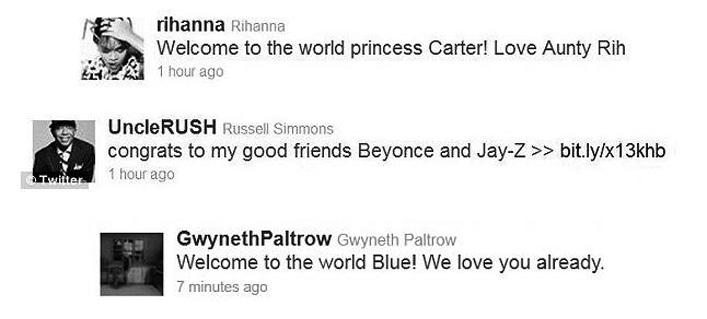
Repeat after Me: Power Isn’t a Dirty Word!
Creating brand “you” means coming to terms with power — your power! It’s a word that’s so misunderstood and, as a result, too often misused. Power has nothing to do with physical strength, tyranny, or who has the biggest office. I’m talking about the power of influence.
Which brings us back to the Vision, Value, Passion (VVP) Connection; those things you have already established as the building blocks of your brand and the essence of your personal brand statement. They contribute greatly to the power of your reputation and make you a highly influential and must-add follow.
On Twitter, this power is measured not only by the number of followers you have, but also by the amplification level of your tweets through retweets and acknowledgements. I answer the quality versus quantity question surrounding Twitter followers in Chapter 6, but for now I focus on the importance of unleashing and using your personal power intelligently, responsibly, and — yes you’ve guessed it — powerfully!
The Halo Effect
One of the things that attract us to certain brands is the power they project. As a consumer, you want to associate with brands whose powerful presence creates a halo effect that rubs off on you — and it’s the same on Twitter. Remember that power is perception and that perception starts on an internal level. In other words, if you want others to see you as highly influential then you need to see yourself that way first.
After all, you are already a leader — you’re leading brand “you,” so you need to ensure that your Twitter presence recognizes this and influence others to follow.
I have identified seven key influence strengtheners for your personal brand on Twitter, which I introduce here and expand on extensively throughout the book.
1. Keep the home fires burning
Don’t neglect your personal brand’s website, and do ensure that it resonates with the passion of your personal brand statement. Whether you create it yourself or pay a professional website company to design it, having an approachable and clean online home base for both your professional and social streams is a necessity.
As you are the brand itself, the best domain you can acquire is your first and last name, or something close to it.
However, this can be difficult, as website domains are being picked up like candy and finding your own name is often impossible, especially if it is a common one like Smith or Jones. Luckily, I was able to secure www.sarahjaynegratton.com a few years ago, but it’s always a good idea to have some well-thought-out backup names just in case. Play around with terms that define you as a brand and that echo your personal brand statement. These terms will also make excellent domain names for your website.
2. Keep blogging sharable content
Although so-called online experts regularly declare that blogging is dead, I believe blogging has simply evolved and become far more diverse. It is no longer necessary to write multiparagraph posts; instead, services such as Tumblr and Posterous Spaces make it easy for individuals to share shorter entries or snippets of text that often include photos and other media, or to use their Twitter accounts to generate self-sustaining blogs that show what’s trending for their personal brand (see Figure 3-6).
Remember that sharable content is a great influence strengthener for your personal brand, steering your Twitter audience to it, and establishing yourself as an expert in your field.
Figure 3-6
Twylah translates your tweets into a uniquely personalized blog page.
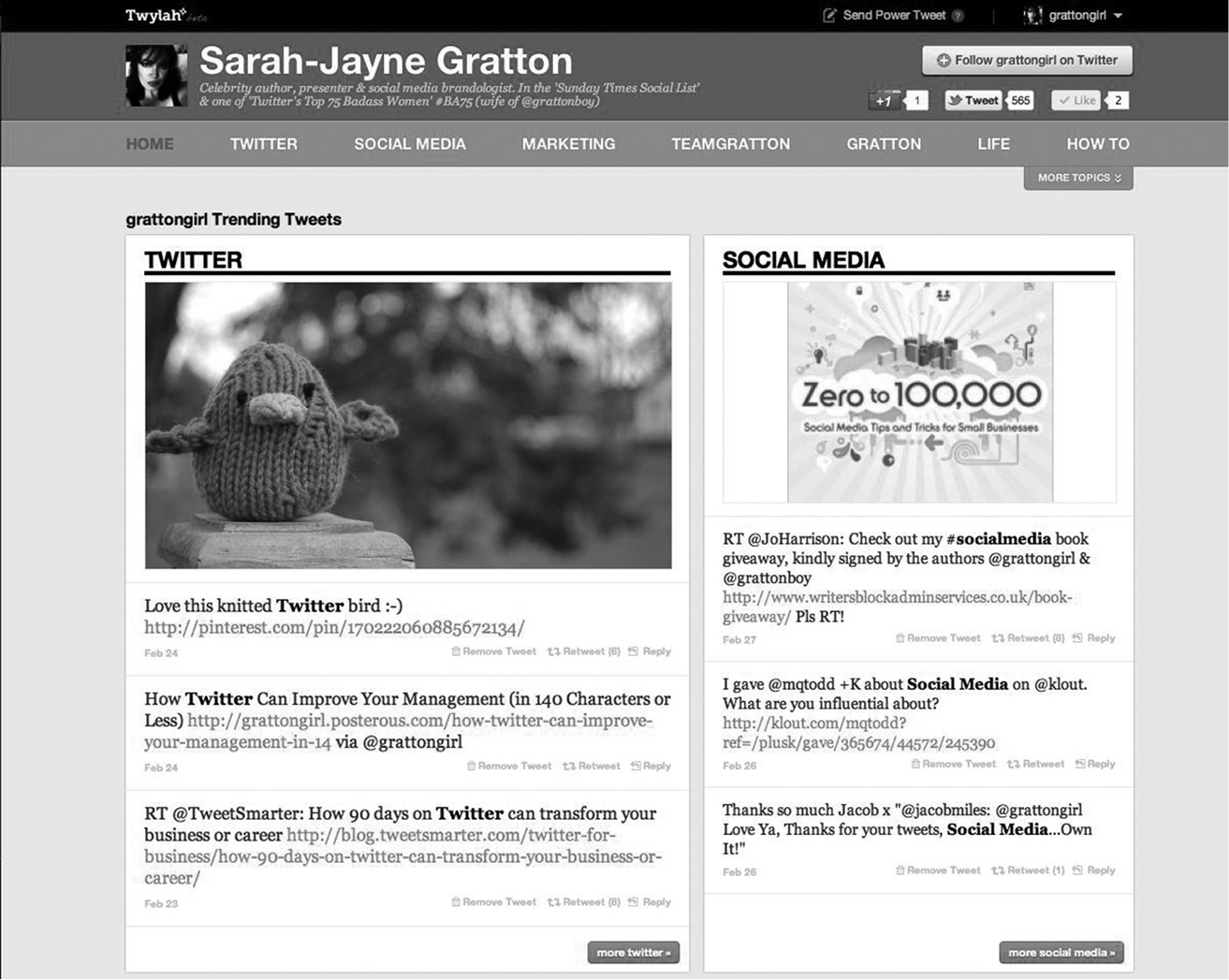
3. Avoid mobile mistakes
In November 2011, top tweeter Ashton Kutcher posted a tweet defending Penn State’s Joe Paterno without doing his homework about the sex-abuse controversy surrounding the coach (see Figure 3-7). His tweet resulted in a catastrophic frenzy of furious replies from Kutcher’s millions of followers. Once again, this is a prime example of how 140 characters or less can immediately damage someone’s reputation and subsequently their personal brand.
With more and more of us tweeting from our cell phones, it’s far too easy to make a real-time mistake like this; whether it’s updating your status with an inappropriate comment or letting auto-correct do digital damage. In other words, when networking on the go make sure you carefully review what you are about to tweet before pushing that Send button.
Figure 3-7
Ashton Kutcher’s badly thought-out Twitter post resulted in a frenzy of furious replies.

4. Interaction, interaction, interaction!
Take a look at the most popular noncelebrity personal brands on Twitter and see how frequently they interact with their followers. You’ll find that if they’re not sharing great content, they are either responding to messages or retweeting their followers to keep the conversation going.
And it doesn’t have to be a full-time job. A carefully thought-out Twitter strategy can provide the interaction your brand needs without taking up too much of your valuable time.
Chapter 5 reveals the secrets to building a strong and trusted Twitter dialog for your brand. By learning both the architecture and the formula needed to create great tweets on a daily basis, you will quickly build your popularity and influence across the Twitterverse.
Remember, there has been a shift from a monolog-based to a dialog-based approach to brand promotion (see Figure 3-8). Your followers are an integral part of your brand content. Keep them involved and they will increase in number.
Figure 3-8
An example of Twitter dialog communication that has replaced the older monologue forms of brand promotion.

5. Use hashtags
Hashtags might be one of the hardest things for new Twitter users to learn, but they are invaluable. The hashtag, or the # symbol, is used on Twitter to tag a topic or keyword in a tweet. The most popular are known as trending topics.
A great example of how powerful hashtags can be is that just seconds after Beyoncé and Jay-Z’s name for their new baby girl was incorrectly announced as Ivy Blue, the Twitter hashtags #IvyBlue and #NamesBetterThanIvyBlue were created, with hundreds of tweets flowing about the strange choice of baby’s name, and making them instantly trending topics. Of course, these hashtags were created when it was thought that the baby’s name was Ivy Blue. Later, the hashtag was changed to #BlueIvy.
Close friends of Beyoncé and Jay-Z tweeted their congratulations to share their well-wishes, not only with the new parents, but with their followers, too. Gwyneth Paltrow (@GwynethPaltrow) tweeted, “Welcome to the world, Blue! We love you already.”
By learning how to use the right hashtags, your tweets can reach a far larger audience and, as a result, substantially increase your influence. But knowing how to create trending topics that will really make an impact is something of a mystery. I lift the lid and reveal everything you need to know about creating them in Chapter 10.
Figure 3-9 shows how Twitter has evolved its hashtag search through its Discover pane, along with a list ofWorldwide Trends on the home page.
Figure 3-9
Twitter has evolved its hashtag search facility through the introduction of the Discover pane.

6. Create lists and get listed
Twitter offers you the ability to create extensive lists composed of other Twitter users. These lists categorize users by the topics they cover, becoming invaluable depositories of information on various subjects.
Creating lists that relate to what you enjoy or tweet about can help spread your influence on Twitter, both with the people included on your lists and anyone looking for tweets on those subjects.
As you become known as an expert in your field, you will be listed time and time again in subject relevant lists and, on a wider level, through the kind of tweeter you are, in lists such as Follow, Top Tweeters, Influential Women, Visionaries, Inspirational, and other lists that single you out as someone with a great deal of influence and who’s an essential follow. Figure 3-10 shows a snapshot of some of the lists that feature the @grattongirl brand. In Chapter 6, I explain how to create lists that get plenty of attention and, likewise, how to ensure your personal brand is listed again and again.
Figure 3-10
Just a few of the many lists that feature the @grattongirl brand on Twitter
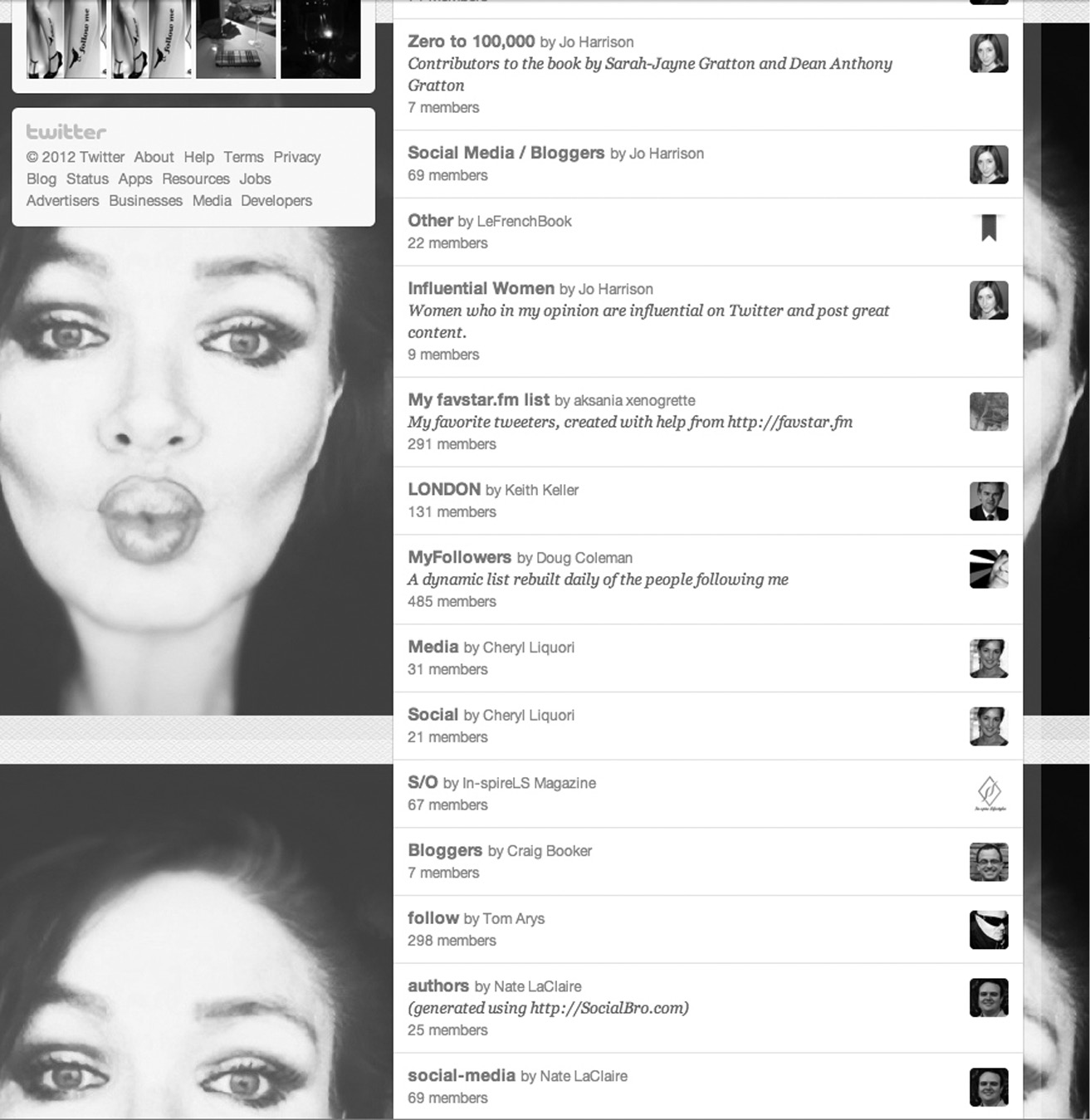
7. Timing is everything
Knowing the best time of the day to tweet can be something of an art form, but fortunately there are tools available that enable you to reach your global following at the best possible times of day. The question is no longer “Should we spend our time on Twitter?” but “How can we optimize our time on Twitter?”
And the key to maximizing your return from Twitter really comes down to timing your tweets for success. This means getting to know your audience and understanding the differences between time zones when planning your tweet schedules. It’s also a great way to incorporate Twitter lists, allowing you to group followers according to time zone and peak Twitter periods.
As the book progresses, you’ll learn all you need to know about maximizing your tweet timing for greater exposure and increased influence.
So, now you’ve learned the importance of giving your personal brand a strong voice from the start. The next step is to transform your voice into a great Twitter profile; one that truly lets it shine and quickly attracts a strong and loyal following. The next chapters show you how to achieve this profile in just minutes.
So what are you waiting for? Let’s start building your personal brand profile!

